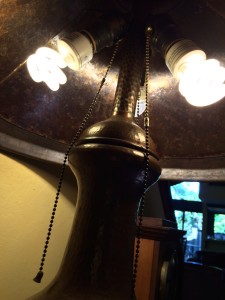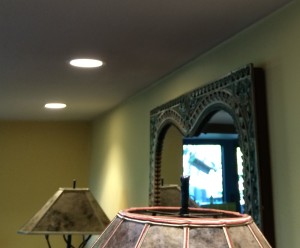The typical news today about LED bulbs is about their rapid adoption, their dropping prices, and supporting legislation. The bigger story is about exploiting the IOT (Internet of Things) infrastructure that surrounds them.
 Lightbulbs have great established infrastructure. Each receptacle is wired for power. Bulbs have standard screw bases for simple bulb installation.
Lightbulbs have great established infrastructure. Each receptacle is wired for power. Bulbs have standard screw bases for simple bulb installation.
Light bulbs are everywhere. The average American home has about 40 receptacles for light bulbs. By various estimates there are between 2 billion and 4 billion light bulbs installed in the U.S. That number represents an eighth of the world market.
Traditional incandescent bulbs have a simple function. They glow when they are supplied with power. Manufacturers of LED bulbs are already adding functionality, mostly copying or extending what traditional bulbs do. There are LED bulbs that can dim, ones that can change color, and so on. They can be controlled from a phone or computer via WIFI.
“Smart bulbs” cost more, but they save energy and last longer. A typical LED bulb used three hours per day should last 20 years or more. This long expected product life changes our perception of a bulb from a short-lived disposable to a pricier but long-lived appliance.
What could be incorporated in a light bulb?
- Think sensors. Motion, light, sound, smoke and heat sensors could be integrated into bulbs.
How could that work if the power to the bulb is off? Suppose that power to a bulb is generally left on but the bulb has a smart circuit that turns the glow on or off. A bulb could glow depending on any number of factors including darkness, detected motion, time of day, sound and commands sent via the WIFI.
Bulbs could have batteries so that they can still perform some actions when their power is off for an extended time, such as emergency lighting or communicating a message through a WIFI. They could trickle charge the battery and run computations without glowing.
Staying close to conventional bulb functionality, lights could adjust brightness according to need. Just say “More light” if you want more brightness and “Lights out” if you want darkness, and so on.
 You could even give simple commands through a light switch. Flick the switch twice to turn the glow on. Flick it once to turn glow off. Flick it three times to go to a brightness adjusting mode where each additional flick brightens the glow a little.
You could even give simple commands through a light switch. Flick the switch twice to turn the glow on. Flick it once to turn glow off. Flick it three times to go to a brightness adjusting mode where each additional flick brightens the glow a little.
How else can we go beyond familiar lighting functions?
- Think speakers and transducers. Light bulbs could include speakers that provide audio messages. “Johnny says he loves you.” “The postman left something in the mail box.” “Kids, remember to shut the door.” “Please turn the light switch by the front door back on.”
- Think cameras and security. Security cameras could be placed in light bulbs at strategic locations. Security bulbs could communicate images of faces or eyes to unlock doors for authorized people.
- Think fire safety. Light bulbs with built-in smoke or carbon dioxide detectors could function as alarms in many rooms. You should never have to change a battery to stay safe.
- Think communications and controls like in the Star Trek Next Generation shows. “Computer. Connect me to Number 1.” OK, less stilted language. “Run the dishwasher after 9 PM tonight.” “Take a message for ‘Hot Lips’ when she gets home.” (I’d better stop there.) “Thanks for cleaning the place up. Got any messages for Barbara?”
- Think lights as timers for activities — subtly announcing that time is up or that it is time for something.
- Think games. You hide something for your wife and the lights lead the way.
- Think nagging. “Ryan, your mom asked you to wash your dishes before you leave.” OK. Don’t think nagging.
- Think how easy it is to install a light bulb.
So, what is the right operating system for a light bulb? That answer will change with time, but these examples of applications suggest that there is value in supporting multi-processing and other familiar capabilities for embedded systems. Viewed this way, light bulb systems should be developed as a standard part of a system of systems.
What other IOT devices would be useful in light bulb sockets?
Thanks to Eric Bier, Danny Bobrow, Kyle Dent, Raj Minhas, Ashwin Ram, Frank Torres, Michael Youngblood, and Ed Wu for earlier conversations on this. Thanks to Barbara Stefik for providing pictures while I was spending time at the airport writing this.
